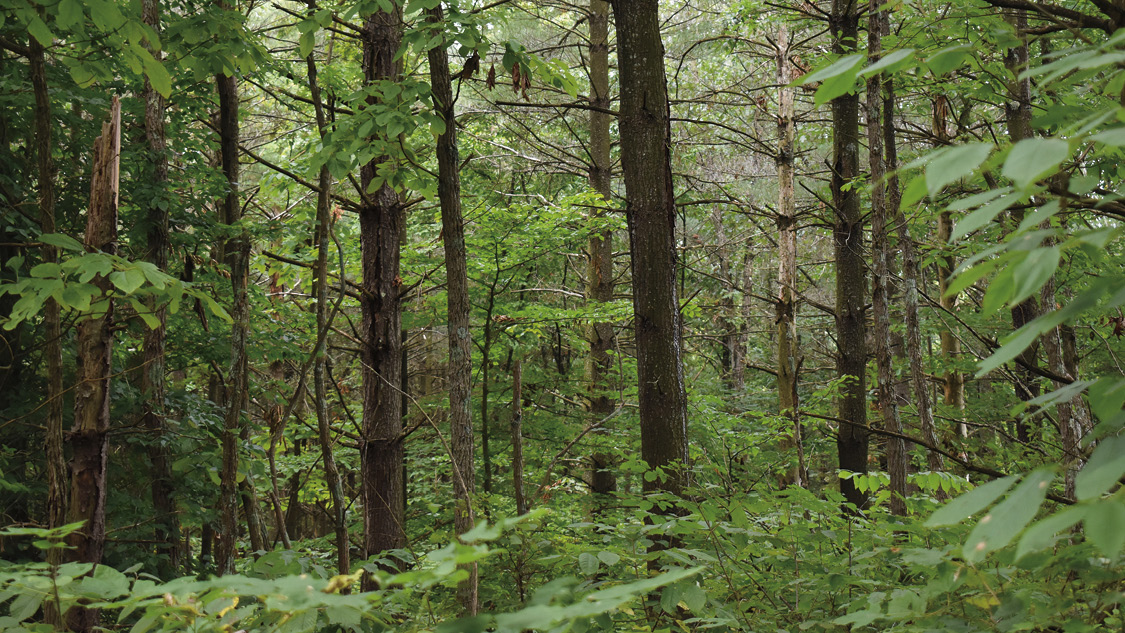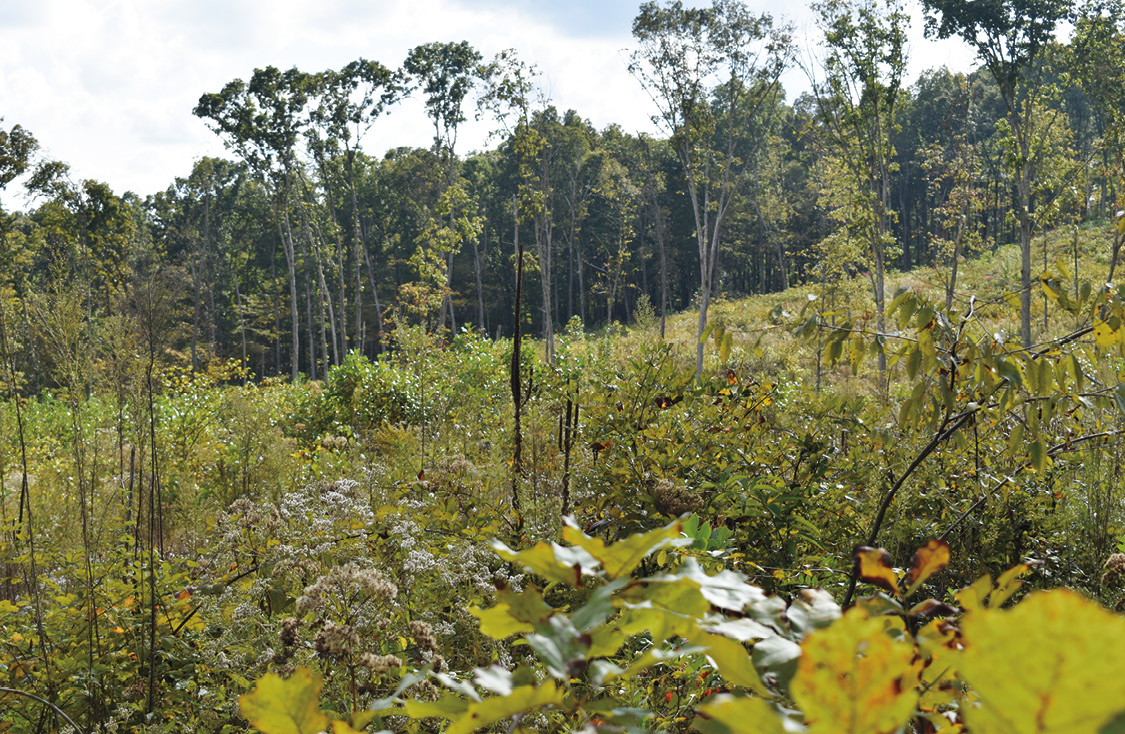Ecological Restoration on the Hoosier National Forest
Disturbance has always influenced our forests. During the Pleistocene, temperate zone forests were much more open than the dark, closed forests of today and included sun-loving herbaceous plants interspersed among the trees. The openness was primarily due to the feeding and activity of the mammals present at that time (mastodon, giant bison, giant ground sloth, etc.). Disturbance also occurred due to wind, ice and snow, and outbreaks of pests and disease. Native Americans greatly influenced the land in North America for millennia, primarily with fire. Burning provided the habitat for game (deer, bison, elk), cleared areas for settlements and crops, improved visibility and travel, and increased fruit production, among other benefits. Other keystone species, including beaver and passenger pigeons, created sizeable openings through disturbance caused by their natural activities. When conditions changed, or species moved on, these openings regrew, creating a diverse mosaic of forest age classes, structure and types across the landscape. Wildlife species adapted to these diverse habitats.
Fast-forward to the 20th and 21st centuries and we find that due to human activities, in the eastern U.S. natural forces are either not here (fewer beavers, loss of passenger pigeons and bison), are suppressed (fire), or due to fragmentation can’t be effective on a large enough scale (wind, storms) to create or maintain a similar habitat mosaic. Therefore, present day land managers and landowners in the east must now create disturbance that mimics those natural forces through the tools we have available – including various types of timber harvest and prescribed fire - to keep a diverse forest mosaic on the limited amount of forest remaining. In addition to creating diverse wildlife habitat, these silvicultural treatments create a forest that is healthier and therefore more resilient to pests and a changing climate. Some silvicultural activities also provide sustainable wood products for the public and support rural economies through the wood products industry.
The overriding objective of the Forest Service is to ensure that national forests are managed in an ecologically sustainable manner. Here in the central hardwood region, the ecological priorities of the Hoosier National Forest are to restore and maintain the oak-hickory community on drier sites, diversify forest age classes, restore native hardwoods in areas planted with non-native pine, and improve forest health and resiliency. To achieve these priorities, disturbance is necessary.
Disturbance in the form of timber harvest allows sunlight to reach the forest floor, providing oak and hickory sprouts and seedlings the conditions they require to grow large and become competitive. Periodic low intensity prescribed fires reduce competition, allowing them to grow into mature trees. Sunlight and fire also encourage a community of associated trees, shrubs, vines and a rich herbaceous ground cover providing critical wildlife habitat. We use the shelterwood harvest method to perpetuate the oak-hickory community, with half of the overstory and most of the midstory removed initially to let light in. The next step generally occurs several years later and involves using prescribed fire to reduce competition and get the oaks and hickories to the sapling stage. When that occurs, a majority of the remaining overstory trees are removed giving the oak-hickory saplings full sunlight to thrive and become mature. Without active management, the oak-hickory community will not continue to produce mature trees (due to closed-canopy shaded conditions and competition) and the forest will lose its species diversity as it is replaced by predominantly shade-tolerant American beech and sugar maple. The majority of the Hoosier National Forest will still consist of these mesophytic communities. A forest is healthiest when diversity is high, and loss of the oak-hickory community would decimate many wildlife populations.
After European settlers cleared land for their needs, followed by unregulated timber harvesting and failed agriculture, pines were planted throughout much of southern Indiana to restore the soil and control erosion. The pines were effective and today we are working to restore native hardwoods by clearcutting the non-native pines in small areas, many of which are now in declining health. Upon the removal of the non-native pines, we are afforded a decade of prime young hardwood forest habitat that has become increasingly rare on the landscape. Research shows that many bird species depend on young forest for all or part of their lifecycle. Data indicates these birds are declining across North America due to lack of habitat, as forests in the 0-9 year age class become increasingly rare, especially on private land. Natural disturbance processes cannot create enough young forest to sustain viable populations of the wildlife species that require it. On the scale that young forest habitat is currently needed, disturbance through timber harvest and prescribed fire is essential to making meaningful progress. In addition, native hardwoods will provide better habitat and food sources for native wildlife and be more resilient than most pine species in a changing climate. Overstocked eastern white pines in the Buffalo Springs Restoration Project area are proposed to be clearcut in 10-acre parcels to restore native hardwoods and provide young forest habitat. Eastern white pines are experiencing declining health in response to the changing climate here.
Overstocked eastern white pines in the Buffalo Springs Restoration Project area are proposed to be clearcut in 10-acre parcels to restore native hardwoods and provide young forest habitat. Eastern white pines are experiencing declining health in response to the changing climate here.
Forest health is improved by thinning overly dense stands to reduce stress and increase growth of individual trees. Stressed trees are more susceptible to attacks from forest pests and pathogens. Single-tree and group selection harvests reduce density for improved forest health, and create a mixed age forest to provide habitat for a wider array of wildlife. Selection harvests are utilized on higher quality sites where species like American beech and maple thrive. These species regenerate well with this type of harvest and provide the diversity that will ensure a healthy forest into the future. An oak-hickory regeneration site in Crawford County had the final overstory cut of the shelterwood method completed in fall, 2020. This October, 2021 photo shows a dense young forest.
An oak-hickory regeneration site in Crawford County had the final overstory cut of the shelterwood method completed in fall, 2020. This October, 2021 photo shows a dense young forest.
In 2021, the Forest Service proposed the Buffalo Springs Restoration Project for an area of the Hoosier National Forest south of Paoli, in Orange and Crawford Counties. The project goals are to improve the sustainability of the oak-hickory ecosystem, regenerate native hardwood communities by removing non-native pines, and improve overall forest health and wildlife habitat. Proposed treatments would occur over a 10-15 year time period and would include:
• 707 acres of non-native Eastern white pine to be clearcut in areas no larger than 10 acres
• 516 acres for shelterwood treatment
• 2,689 acres for either pine or hardwood thinning
• 957 acres for selection harvests (either single tree or groups of up to 3 acres)
• 255 acres for timber stand improvement
• Up to 12,135 acres of National Forest to be treated with prescribed fire. If local landowners whose property adjoins the National Forest opt to be included, this could increase to a total of up to 15,100 acres.
Following an initial public scoping period to identify issues, an interdisciplinary team of resource specialists is currently analyzing the proposed project area and expect to produce a draft environmental assessment in April, 2022, followed by a 30-day public comment period. Plans are being made for a field tour on April 22, and a virtual public meeting on April 26. We invite all interested citizens to get involved in the management of their public lands. More information about this project and details on how to participate can be found on the Forest’s social media (@HoosierNF) and website: https://go.usa.gov/xAn24
With over 80% of forested land in Indiana in private ownership, landowners have a significant opportunity to contribute to ecosystem restoration and forest health across the state. Consulting with your District Forester is a good place to start. For more information visit: https://www.in.gov/dnr/forestry/private-forestland-management/district-foresters/
Marion Mason is a Public Affairs Specialist for the Hoosier National Forest. She has a B.S. in wildlife management from Virginia Tech, and is a certified interpretive guide with the National Association for Interpretation.
Travis Swaim is the Forest Silviculturist for the Hoosier National Forest. He has a B.S. in Public and Environmental Affairs from Indiana University, a M.S. in Forestry from Purdue University, and has completed the National Advanced Silviculture Program to become a Certified Silviculturist for the USDA Forest Service.
